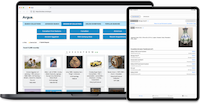Accessibility Standards for Museum Collections Online

Rachael Cristine Woody
On April 24, 2024, the United States Department of Justice (DOJ) Civil Rights Division published a final rule to its update for Title II of the Americans with Disabilities Act (ADA).
In it, the DOJ stipulates that government entities must meet the World Wide Web Consortium (W3C®) technical standards set forth in the Web Content Accessibility Guidelines (WCAG) Version 2.1, Level AA. As explained in the DOJ Fact Sheet, Title II is specific to state and local programs that provide the public with services, programs, or other activities. As such, they are required to follow accessibility requirements as set forth by the DOJ Civil Rights Division as this helps to ensure equal access to these public goods. Described in the Fact Sheet as the final rule, it applies to the accessibility of web content and mobile apps. Depending on the size of population served, government agencies have 2 to 3 years to come into compliance—with the deadline either April 2026 or April 2027.
For a quick-glance of the rule, please see Fact Sheet: New Rule on the Accessibility of Web Content and Mobile Apps provided by State and Local Governments.
Why Accessibility is Important
A statistic the W3C® shares in their Video Introduction to Web Accessibility and W3C Standards is that 15-20% of the population are people with disabilities, or—to frame it another way—there are more than 1-billion people with disabilities. Additionally, they cite The UN Convention on the Rights of Persons with Disabilities defining access to information is a human right.
How This Relates to Museums
Full and equal access to services, programs, and other government-offered activities must be supported—in this case, online. This includes museum collection offerings published online via a Collections Management System (CMS). Even if your museum isn’t a government entity, it is considered best practice (and the ethical thing to do) to meet these federally outlined requirements. In addition to offering equal access and servicing a decent size of the population, the museum’s online content and community of users also benefit in the following ways:
- Increases collections online to all online constituents.
- Improves the user experience for everyone.
- Fulfills requirements from granting agencies and foundations.
- Supports search engine indexing and discoverability of collections content online.
WCAG is the International Standard
When considering the accessibility of museum collections content online, the most often referenced best practices are the WCAG. WCAG was created by the Web Accessibility Initiative at the WC3®, and is an international standard (ISO 40500).
A Note on WCAG Versions and Ratings
WCAG 2.1 covers a wide range of recommendations for making web content more accessible. It was first published June 2018 and last updated September 2023. There is just one more recent version available currently: WCAG 2.2, published October 2023. WCAG 3 drafting is underway, though it will reportedly be a few years before it’s ready. The current set of WCAG standards use a 3-tier ranking of A (good), AA (better), and AAA (best).
The Purpose of the WCAG
WAI offers freely available guidance, success criteria, examples, and resources for evolving web content into an improved form of accessibility. WAI states that:
Following these guidelines will make content more accessible to a wider range of people with disabilities, including accommodations for blindness and low vision, deafness and hearing loss, limited movement, speech disabilities, photosensitivity, and combinations of these, and some accommodation for learning disabilities and cognitive limitations; but will not address every user need for people with these disabilities. These guidelines address accessibility of web content on desktops, laptops, tablets, and mobile devices. Following these guidelines will also often make Web content more usable to users in general.
While our use regarding these accessibility standards will be focused on the public museum collections content as published by the museum CMS, these standards can be used by museums to evaluate any of their online content.
Conclusion
Over the next few weeks, we’ll review these broadly applicable standards and explore how they may relate to the CMS presentation of museum collection content online. This will include consideration of the CMS navigation, the presentation of data and collection information, and the accessibility of digital assets (digital surrogates of the collection). Next week begins with Principle 1: Perceivable.
Accessibility Resources
Center for Disease Control, Disability and Health Inclusion Strategies, https://www.cdc.gov/ncbddd/disabilityandhealth/disability-strategies.html.
Case Western Reserve University, What is Accessibility?, https://case.edu/accessibility/what-accessibility.
Fact Sheet: New Rule on the Accessibility of Web Content and Mobile Apps provided by State and Local Governments, the Department of Justice Civil Rights Division, https://www.ada.gov/resources/2024-03-08-web-rule/.
Hand Talk, Accessibility: What Does it Mean, What are the Purpose and Types, https://www.handtalk.me/en/blog/accessibility/.
Notice
Copyright of the World Wide Web Consortium (W3C®). This document includes materials copied or derived from the Web Accessibility Initiative (WAI) website. Specific resources are credited below, in accordance with the W3C’s Using WAI Material: Permission to Use with Attribution policy and specifications for a W3C Document License.
Citation 1: Video Introduction to Web Accessibility and W3C Standards. Updated 4 May 2021. First published 4 December 2017. Project lead: Shadi Abou-Zahra. Contributors: Shawn Lawton Henry, Judy Brewer, Eric Eggert. Videographer and video editor: Ulrich Grimm, av-design GmbH. Copyright © 2021 World Wide Web Consortium. W3C® liability, trademark, and document use rules apply.
Video clips developed with support from the WAI-DEV project, co-funded by the European Commission. Translations managed with support from the WAI Expanding Access project, funded by the Ford Foundation.
Citation 2: Introduction to Understanding WCAG (Version 2.1). Updated 20 June 2023. Developed by Accessibility Guidelines Working Group (AG WG) Participants (Co-Chairs: Alastair Campbell, Charles Adams, Rachael Bradley Montgomery. W3C Staff Contact: Michael Cooper). Copyright © 2023 World Wide Web Consortium. W3C® liability, trademark, and document use rules apply.
The content was developed as part of the WAI-Core projects funded by U.S. Federal funds. The user interface was designed by the Education and Outreach Working Group (EOWG) with contributions from Shadi Abou-Zahra, Steve Lee, and Shawn Lawton Henry as part of the WAI-Guide project, co-funded by the European Commission.
Citation 3: Web Content Accessibility Guidelines (WCAG) 2.1. W3C Recommendation 21 September 2023. Editors: Andrew Kirkpatrick (Adobe), Joshue O Connor (Invited Expert, InterAccess), Alastair Campbell (Nomensa), and Michael Cooper (W3C). Copyright © 2020-2023 World Wide Web Consortium. W3C® liability, trademark, and document use rules apply.

Rachael Cristine Woody
To learn more, please join us for the companion webinar Accessibility Standards for Museum Collections Online, Wednesday, July 31 at 11 a.m. Pacific, 2 p.m. Eastern. (Can’t make it? Register anyway and we will send you a link to the recording and slides afterwards). Register now.
**Disclaimer: Any in-line promotional text does not imply Lucidea product endorsement by the author of this post.
Never miss another post. Subscribe today!
Similar Posts
Exploring No-Code Digital Storytelling: Hoover’s “Fanning the Flames” Exhibit
Explore no-code digital storytelling with Hoover’s ‘Fanning the Flames’ exhibit. See how interactive tools (Deep Zoom Color Compare & Hot Spot) enhance user engagement and the visual experience.
An Introduction to Scrollytelling for Museums
Discover how museums use scrollytelling and digital storytelling platforms to create immersive narratives. This introduction explores key concepts and approaches to interactive storytelling.
Exploring Self-Determinate Multiple Pathways: An Example of Digital Storytelling
Discover how self-determinate multiple pathways offer flexible interactive storytelling in museum exhibits. Learn from the Tenement Museum’s ‘Your Story Our Story.’
Digital Museum Storytelling Example: A Look at Self-Determinate Linear Pathways
Self-determinate characteristics on a linear pathway go beyond brief sidebar topics and instead offer alternative ways to navigate the linear pathway.







Leave a Comment
Comments are reviewed and must adhere to our comments policy.
0 Comments